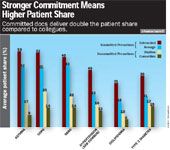Sales Management: Get Committed
Pharmaceutical Executive
Pharma companies today are focused on driving prescriptions. But just because physicians are prescribing a brand doesn't mean that they are committed to it. Who's to say a doctor won't jump ship the moment a flashier new drug comes on the scene?
Pharma companies today are focused on driving prescriptions. But just because physicians are prescribing a brand doesn't mean that they are committed to it. Who's to say a doctor won't jump ship the moment a flashier new drug comes on the scene?

Jeffrey Zornitsky
To strengthen the tie between pharma and physicians, companies must add new metrics and insights to their sales management and decision-support systems—metrics that look at the company's relationships with prescribers. A key metric is commitment, a measure of the underlying bond between doctors and the brands that they prescribe.
Commitment drives near-term performance gains and ensures long-term stability. Research shows that committed physicians deliver more than double the patient share of their uncommitted colleagues (see chart, right). In addition, committed doctors are more resistant to competitive efforts and less sensitive to drug pricing, which translates to more prescriptions over time.
Conversely, high prescribers can also be uncommitted—and could easily be persuaded to switch to another brand. Even companies that think their sales numbers are safe may be facing unforeseen challenges. Commitment is a critical component of traditional prescription metrics—and a weak physician–sales relationship could prove to be an Achilles heel for even the strongest brands.

Stronger Commitment Means Higher Patient Share
The effort to manage commitment depends in large part on how well the company understands what physicians need and where the fulfillment of those needs is falling short. This insight is key in developing a physician-centric sales approach.
What Physicians Really Want
What does it take to build commitment? TNS Healthcare recently interviewed nearly 400 doctors (including PCPs, cardiologists, pulmonologists, and oncologists) in the United States and asked them to identify the pharma-related services they value (see chart).
PCPs and specialists alike agreed that industry is not meeting their changing requirements. They cited gaps in several key areas, such as patient-management programs, education and information services, and detail quality. Clearly, physicians are not finding value in the experiences pharma is delivering.
With few exceptions, physicians gave pharma low ratings in almost all sales and service areas. Only about a quarter of physicians gave the industry good marks for Internet services, business management support, or DTC programs. Only about half said they were satisfied with detail quality and brand experience—and even fewer gave the industry high ratings for either patient or physician education.

Qualities and Services Physicians Value Most from Pharma Companies
Despite these low average ratings, some companies are doing better than others at meeting physicians' needs. Pfizer comes out at the top of the list, across all sales and service categories. GlaxoSmithKline and Novartis tie for second, with relatively high scores in most areas.
Getting Physician-Centric
One way to improve these scores is for pharma companies to adopt a physician-centric approach to managing physician relationships. By moving from just selling products to becoming educators, knowledge providers, and business partners, companies can improve relationships with doctors. This approach requires customizing the total sales experience to physicians' expressed preferences—and in the process, ensuring that the required investments will yield positive ROI. Achieving this requires a new set of decision-support metrics, tools, and delivery mechanisms.
Relationship Optimization
Managing from the physician's point of view begins with communication. Companies must talk to their target audience to gather information on doctors' behaviors, relationship views, and needs. With this information in hand, pharma companies can structure a physician sales-and-service experience plan that will build stronger relationships and help optimize prescribing and market share.
Here are three basic steps for creating a physician-centric sales plan:
- Evaluate and assess Companies must first assess physician relationships. This involves determining the strength of current relationships, documenting physician needs and how well they are being addressed, and relying on decision-support tools to identify which improvements will yield the greatest benefits. Typically, surveying physicians and combining the results with in-house sales and promotional-activity data can accomplish this. For example, some companies have discovered that their prescribers want more than just a better detail. They want more information services or education programs.
- Resource allocation and execution Once all the information is gathered, pharma companies must tailor a plan that will both build patient share and improve physician satisfaction. Companies can establish relationship-experience plans on varying levels, from a district and territory level down to a granular physician level. There are new tools available to help companies evaluate the impact of improving elements of the sales experience, so they can allocate resources more productively. Sales and marketing executives can look at alternative investment options—such as speaker programs and patient education offerings—and determine the incremental value they'd gain in terms of commitment, share, and dollars, from raising their experience scores in each area. As a result, they can quantify opportunities to improve physician experiences—and focus on prescribers who will deliver the greatest performance gains.
- Track and improve In order to continuously evaluate brand performance, companies should design and implement a tracking capability, such as Internet surveys. Return on investment is gauged by constantly resurveying doctors to determine whether they are using a brand, where their commitment stands, how they're evaluating their experiences, and if they've switched to or from a different brand.
Sales Reps: The Final Link
The final stage of this approach is defining the role of the sales rep. Are reps simply visiting physicians to provide a quality detail, or is the sales rep the conduit between the physician and the products and services that the company offers?
The rep provides or influences much of the physician's experience with a pharma company. So all the collected commitment data eventually trickles down to sales force management and training. What physicians expect from their sales rep can be custom tailored in a behavior profile (included in a relationship-management system), and driven by basic sales rep training.
Commitment also can be used for providing incentives to district sales managers. If the district managers are being asked to improve commitment and performance on a set of key drivers, companies can build performance-improvement expectations into their incentive compensation program.
Will this relationship-management approach pay off? Evidence shows that investing in the right experiences will drive brand commitment and grow share. In today's competitive environment, it is not enough to have high prescribers. For long-term success, companies must have committed prescribers—doctors who not only write prescriptions for their brand today, but also stick with it tomorrow.
Jeffrey Zornitsky is senior vice president of sales performance optimization at TNS Healthcare. He can be reached at jeffrey.zornitsky@tns-global.com

The Misinformation Maze: Navigating Public Health in the Digital Age
March 11th 2025Jennifer Butler, chief commercial officer of Pleio, discusses misinformation's threat to public health, where patients are turning for trustworthy health information, the industry's pivot to peer-to-patient strategies to educate patients, and more.
Navigating Distrust: Pharma in the Age of Social Media
February 18th 2025Ian Baer, Founder and CEO of Sooth, discusses how the growing distrust in social media will impact industry marketing strategies and the relationships between pharmaceutical companies and the patients they aim to serve. He also explains dark social, how to combat misinformation, closing the trust gap, and more.